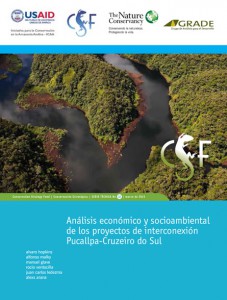Análisis económico y socioambiental de los proyectos de interconexión Pucallpa-Cruzeiro do Sul
| Year | : | 2015 |
|---|---|---|
| Author/s | : | Álvaro Hopkins, Alfonso Malky, Manuel Glave, Rocío Ventocilla, Juan Carlos Ledezma, Alexs Arana |
| Area/s | : | Natural resources, extractive industries and social conflict |
[2015] HOPKINS, Álvaro, MALKY, Alfonso, GLAVE, Manuel, VENTOCILLA, Rocío, LEDEZMA, Juan Carlos y Alex ARANA. Análisis económico y socioambiental de los proyectos de interconexión Pucallpa-Cruzeiro do Sul. Conservación Estratégica. Serie Técnica, 32.
Large transportation infrastructure projects play a strategic role in economic development, but many are implemented without clear evidence that they provide a net beneft to the economy. The magnitude of potential losses from such projects depends, to a large degree, where they are built. Specifcally, road projects in fragile tropical ecosystems tend to be associated with substantial economic and environmental costs.
There are three important roads in different stages of planning and construction connecting Peru and Brazil through the Amazon region. These roads are part of the Integration of Regional South American Infrastructure program (the Spanish acronym is IIRSA), and have been developed without conclusive proof of economic feasibility, or long run projections of their environmental and social impacts. This has been the case of the Tarapoto-Yurimaguas road (Northern Interoceanic highway) and different stretches on the Southern Interoceanic highway (Abbreviated as IOS in Spanish). The routes are called “Interoceanic” because they form missing links in the road networks that reach to the Pacifc and Atlantic oceans.
The present study focuses on the third Peru-Brazil connection, proposed between Pucallpa, the capital of the Ucayali Region in Peru and the city of Cruzeiro do Sul, in the state of Acre, Brazil. The road is also known as the Central Interoceanic highway (Abbreviated as IOC in Spanish). Our analysis indicates that a road would lose up to US$ 308,9 millions and, in addition, would generate negative environmental and social costs of as much as US$ 456,7 millions. A rail alternative would lose US$ 662,9 millions, plus US$19,2 millions in external costs. The overall economic loss from the rail alternative is less, despite the higher construction costs.
We evaluated the economic feasibility of the road, using new data from the pre-investment study prepared by the Pucallpa-Cruzerio do Sul Road Association. The railroad option analyzed he railroad to which is based on a proposal currently being considered by the Regional Government of Ucayali (GOREU) and the State of Acre. The evaluation of both alternatives includes quantitative analysis of the benefts and costs generated by the main environmental and social externalities.
To assign values to the environmental and social externalities it was necessary to project deforestation in each of three different scenarios: with a railway project, with the road project and without either. The projections were made based on a map of forest-cover change between 1985 and 2011, taking into account key variables that explain land use change during that period.
To complement these analyses, we performed an analysis of the opportunity cost of avoided deforestation in the area of infuence by the interconnection projects. This analysis entailed estimating the proftability of the main productive activities, the benefts and costs their expansion would produce and the socioeconomic impact on people affected by the project.
The road project would be economically infeasible unless 70 percent of the traffic from the Iñapari-Puerto Maldonado stretch of Southern Interoceanic highway was diverted to the Pucallpa-Cruzeiro do Sul route. In other words, 249 vehicles would need to be diverted daily, added to the projected local traffic. That fgure doesn’t consider the environmental or social impacts of the project. When those impacts are taken into account the road project would not be feasible under any circumstances, even if all of the traffic from the Iñapari-Puerto Maldonado stretch were diverted to the Central Interoceanic route.
The railway project is economically unsound even before considering environmental and social costs, due to the high construction costs and limited transport demand in the area. The net environmental and social costs are much less than those caused by the road alternative but still negatively impact the economic viability of the railroad proposal.
Before considering externalities, the road project imposes a lower economic loss than the rail alternative on Peru’s economy. After integrating externalities, however, the railroad is preferable, generating a lower overall level of loss.
Given the apparent economic and environmental disadvantages of the transport alternatives analyzed here, this study highlights the need to seek better options to satisfy the needs for regional development and conservation of the area’s natural resources.






